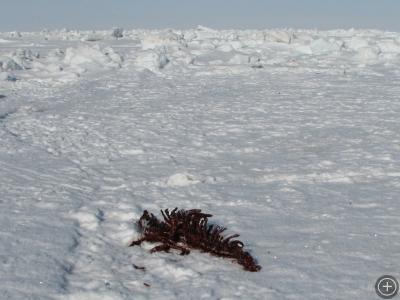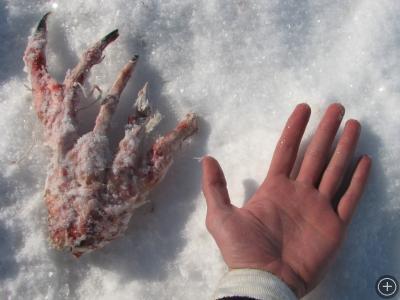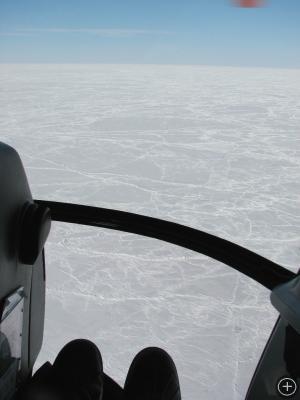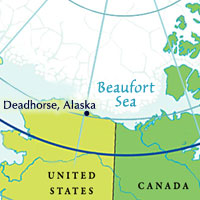Foxes on the Edge
DEADHORSE, ALASKA– Once they kill a seal, polar bears will often eat only the fat and move on. This behavior may have evolved to help maximize their return on investment, allowing them to use a minimal amount of time for eating, but consuming the most energy-rich portion of the seal. I previously described how bears kill seals, during the capture season last spring here. This spring we have seen some kill sites of bearded seals (Erignathus barbatus), which we did not see much of last spring – the bearded seal is much larger than the ringed seal (Phoca hispida) and presumably is more formidable as prey. Once a polar bear leaves the carcass it is available for other scavengers. They aren’t many other animals out on the sea ice, but we have seen birds and frequently, Arctic fox (Alopex lagopus).
Arctic fox seem to make their living by following bears around and scavenging. We have seen foxes trailing behind bears as they travel, and their tracks often wind around bear prints. (My apologies that the pictures below are graphic. However, the carcass below illustrates a critical aspect of the life of predators).

These bones – the vertebral column and attached ribs – are all that remained of a large seal that was most likely killed by a polar bear. The area was covered with fox tracks, and the carcass had been thoroughly scavenged.

Even a flipper had been used for food – the bones of this flipper were intact, showing the similarity to the shape of my hand.
Such an existence seems precarious; polar bears range over great distances, and their successful hunts are few and far between. What if the fox doesn’t find a carcass? It turns out that foxes themselves can be successful predators of young seals. In the early 1970s, a researcher named Thomas Smith trained his Labrador dog to sniff out seal lairs (lairs are in hollow spaces on top of sea ice but below a blanket of snow; seals use these protected spaces to rest and give birth). He spent several winters digging up hundreds of lairs and found evidence that Arctic foxes were able to enter the lairs and predate on young seals. He wrote:
“A keenly developed olfactory sense allows the arctic fox to locate the subnivean seal lair, sometimes through snow depths of over 150 cm…Lairs that had been entered by foxes showed one or more entry holes. Usually the holes penetrated the lair at a slight angle and were never more than 20 cm in diameter…In the case of an apparently successful kill, blood was always present on the floor of the birth lair once the lair had been dug open…When the lair was well developed into a tunneled structure there was usually more blood and the site of the actual kill usually appeared to be in one of the small tunnels”
In fact, Smith concluded that in certain parts of the Arctic, foxes may be more important predators of young seals than bears. However, foxes were never found to kill adult seals, which must be simply too large for a fox to attack. Foxes were also more thorough than bears. They seemed to remain at the site for several days and consume the entire carcass.
So perhaps foxes don’t live as close to the edge as I originally thought, although no animal in the Arctic seems to have it easy. In a very different way, our field season is currently on the edge – due to good weather early on, we flew for more hours than were budgeted, leaving one of our two helicopters in a crunch for funding. We have scrambled to line up addition funding, to support the helicopter for more time; otherwise, we could be forced to end the season in just a couple days. We have had some tremendous luck in locating and re-sampling bears from previous field seasons, giving us great data on how bears fare over time – I really hope we are able to continue flying.

On what has become a rare, sunny day, this is my view through the bubble windshield of the helicopter, wrapping below my feet, as we fly north over the sea ice.
Thomas Smith’s article:
Thomas G Smith. 1976. Predation of ringed seal pups (Phoca hispida) by the arctic fox (Alopex lagopus). Canadian Journal of Zoology, Volume 54, pages 1610-1616.











Hey John. Thanks for another great dispatch. Speaking of training dogs to sniff out seal lairs, the Ice Stories crew captured some great video of a researcher doing just that: Dr. Brendan Kelly trained his Labrador Retriever named Cooper to find ringed seal lairs on the Arctic sea ice. Check out the video here:
http://icestories.exploratorium.edu/dispatches/cooper-sniffs-out-seals/